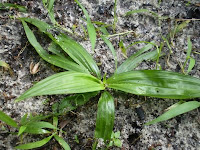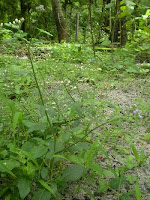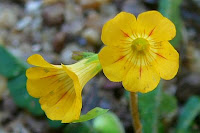ഉഴിഞ്ഞ വിഷ്ണുക്രാന്തി
നിലപ്പന മുയല്ച്ചെവി
ഭൃംഗരാജന്
മുക്കുറ്റി ദുറുവ ചെറുള
നിലപ്പന മുയല്ച്ചെവി
ഭൃംഗരാജന്
മുക്കുറ്റി ദുറുവ ചെറുള
കയ്യോന്നികളിതെന്നിതെല്ലാം
പത്തുള്ള പുഷ്പമിവ
ചൊല്ലത് കേള്പ്പൂ ഞാനും"
This wonderful poem shows importances and necessity of DASAPUSHPAS. We have the responsibility to protect and nurture these holy herbs. Kerala has its distinct medicinal heritage. Dasapushpa, Thriphala, Nalpamara, Dasamooli etc. were a part of our heritage. In early times our health conditions depended on Nattuvaidya. Nowadays only a few grandparents have an idea about dasapushpa.
It is a mixture of ten sacred herbs. On the holy day of karkidaka we place these plants in Poojamury. In the holy month of dhanu, on the day of thiruvathira, women wear dasapushpas on their hair for the benefit of their husbands. Karuka and cheroola are mainly used in traditional practices such as bali tharpana. The bindhi made from mukkutti is used by few people of hindu Religion.
The history of dasapushpas begin from ancient saints . Few parts of ramayana(seetha devi wore dasapushpas) also deals with dasapushpa.The sages who took ayurveda as their upasana knew about the curative properties of many medicinal plants.They identified and later classified the ten plants which has devamsam.
Dasapushpas have some distinct characters other than ordinary medicinal plants.Although they have medicinal properties,their presence itself could bring positive energy to our life. they are commonly known as pure plants.They have the property to control the dasavayu in our body. Although they have infinite medicinal properties, no one cares to protect these sacred plants.
1. UZHINJA
Cardiospermum halicacabum
Fruits are covered with bladder and seeds are globose.
It is well known for huge curative properties. The plant extract has
anti-inflammatory and analgesic properties. It is used in treating
earaches and in relieving swellings. The juice is also used in curing
minor wounds. The juice is said to reduce obesity. The herb is also used
in hair oil preparations to reduce dandruff and for darkening the hair. The herb also has laxative properties. This used to make "thoran" with coconut
scrapes.
2. PUVANKURUNTHAL
Vernonia ceneria
 The plant has erect and cylindrical stems. Leaves are ovate or
lanceolate. The flowers are either white or purple in color and occur in
small head inflorescence. New plants grow from the seeds which are dispersed by
wind. According to
ayurveda the herb has tikta rasa, rooksha guna and ushna veerya.
The plant has erect and cylindrical stems. Leaves are ovate or
lanceolate. The flowers are either white or purple in color and occur in
small head inflorescence. New plants grow from the seeds which are dispersed by
wind. According to
ayurveda the herb has tikta rasa, rooksha guna and ushna veerya.
The herb is known to pacify vata and pitta. The whole plant is useful and has got many curative properties. It is used to cure tonsillitis, stomach ailments etc. the plant is crushed and the juice is made to a decoction by boiling with water which is used to treat fever. The juice extracted from the leaves is mixed with cow's milk and is used to treat conjunctivitis. The juice is also effective in treating poisonous insect bites. The seeds contain fatty oil which is used as an anthelmintic. It is also beneficial in flatulence and intestinal colic. The herb is used to cure problems related to skin like leucoderma and other skin diseases.
It's juice is also used to make kajal
3. MUKKUTTI
Biophytum sensitivum


The plant belongs to the family Oxalidaceae. It is a flowering perennial herb which thrives well in tropical and sub tropical climate. The plant has a very short unbranched stem and the pinnate leaves with small leaflets on either side arise from the tip of the stem. Flowers occur in and are pale yellow to orange in color with five petals .Seeds is enveloped by a stiff and flexible fleece.
The plant is believed to possesses many medicinal properties. The herb has astringent, antiseptic, antipyretic and diuretic properties. According to ayurveda the herb has tikta and kasaya rasa lakhu and rooksha guna and ushna veerya. The herb is known to pacify Kapha and pitta. It is used to treat conditions like arthritis, sprain, stiff neck etc. It is one of the herbs which is given to women after delivery because of its ability to clean the uterus .It is also used in cases of heavy bleeding in women. A paste made of the leaves mixed with butter milk is used in cases of diarrhea. The whole plant is crushed and the juice mixed with honey is administered in cases of cough and chest congestion. According to latest studies, mukkutti's juice mixed with cow's milk has the ability to control sugar level in blood. The paste made from flower is used as bindhi.
4. MUYALCHEVIYAN
Emilia sonchifolia
Emilia sonchifolia belongs to the family Asteraceae. It is commonly
known as cupid’s shaving brush. It is an annual herb
with weak or erect stems. Leaves are ovate or obovate. The plant flowers
from July to October. The flowers are lavender, purple or pink in
color. It occurs in open fields and waste lands. It contains calcium,
phosphorous, magnesium, sodium and potassium. It contains vitamins like
riboflavin and niacin. The herb is used as a folk medicine. According to
ayurveda the plant has katu, kasaya and tikta rasa, lakhu and grahi
guna healer sheeth veerya.
The plant pacifies Kapha, vata and is effective in treating fever,
tonsillitis; juice is a natural for eye diseases. It is also good in
conditions like worm infections and allergy. Whole plant is crushed and
the juice is extracted and is used to cure intestinal worms. The paste
of the plant is useful for bleeding piles. A decoction of the plant is
good in bringing down fever. The herb is useful in treating cough and
bronchitis. Applying a paste on the thyroid region helps to cure the
swelling in is sometimes used in cases of diabetes. Leaves are used to make thoran with coconut crapes.
5. KARUKA
Cynodon dactylon
The plant belongs to the family Poaceae. The plant grows in warm
climate all over the world. The plant has creeping stems bearing roots
at the nodes. It grows and forms a dense mat helping to prevent soil
erosion. The leaves are grayish green in color and flowers are very
small and are in spikes. The grass is considered important in Hinduism
and is dedicated to Lord Ganesh. It symbolizes purity and prosperity. It
contains crude proteins, magnesium, phosphorous, calcium, sodium and
potassium.
The plant has antiviral and antimicrobial properties. The plant has
been suggested for treatment of urinary track infections, skin diseases,
blood disorders, dysentery and prostatitis .Recent studies shows that
the herb is able to reduce blood sugar level in blood. The juice is
cool, sweet and palatable and is nutritious. The whole plant is
medicinal and used externally and internally. The plant extract is used
to relieve discomforts caused due to phlegm. The cooling property of the
plant enables it to mitigate thirst and burning sensation. It works as a
detoxifying agent when taken in empty stomach. The herb mixed with curd
is used in leucorrhea. In
general it is a good tonic for the body.
It grows and forms a dense mat helping to prevent soil
erosion. The leaves are grayish green in color and flowers are very
small and are in spikes. The grass is considered important in Hinduism
and is dedicated to Lord Ganesh. It symbolizes purity and prosperity. It
contains crude proteins, magnesium, phosphorous, calcium, sodium and
potassium.
The plant has antiviral and antimicrobial properties. The plant has
been suggested for treatment of urinary track infections, skin diseases,
blood disorders, dysentery and prostatitis .Recent studies shows that
the herb is able to reduce blood sugar level in blood. The juice is
cool, sweet and palatable and is nutritious. The whole plant is
medicinal and used externally and internally. The plant extract is used
to relieve discomforts caused due to phlegm. The cooling property of the
plant enables it to mitigate thirst and burning sensation. It works as a
detoxifying agent when taken in empty stomach. The herb mixed with curd
is used in leucorrhea. It helps in curing minor cuts and wounds. In
general it is a good tonic for the body.
6. NILAPPANA
Curculigo orchiodes
 The plant is a perennial herb which belongs to the family
Amaryllidaceae. It occurs commonly in temperate climate and is commonly
seen in south India. The plant is widely used in folk medicine. The
rhizome of the plant is used for medicinal purposes. The herb has
madhura and tikta rasa a, guru guna and sheeta veerya. It increases
kapha and reduces vata and pitta.
The plant is a perennial herb which belongs to the family
Amaryllidaceae. It occurs commonly in temperate climate and is commonly
seen in south India. The plant is widely used in folk medicine. The
rhizome of the plant is used for medicinal purposes. The herb has
madhura and tikta rasa a, guru guna and sheeta veerya. It increases
kapha and reduces vata and pitta.
It is used in digestive, respiratory, urinary and reproductive
problems. The herb is found to be beneficial in cases of cough and
asthma. It works and a stimulant and aids digestion. It is also used in
cases of vomiting and diarrhea. The herb is widely used in treating
erectile dysfunction and to increase the sperm count. The plant is
beneficial in treating piles and blood related disorders. It is also
good in skin related ailments.
7. VISHNUKRANTHI
Evolvulus ulcinoides
The herb belongs to the family Convolvulaceae. It is an annual
creeper and grows in open grassy places throughout India. The leaves are
small and are covered with fine hairs. The plant pacifies pitta and is
katu and tikta in rasa, rooksha and teekshna in guna and ushna in
veerya. The flowers are blue in color. The fruits appear in small
capsules.
The herb has astringent properties and is believed to improve
intelligence and memory power and is considered as a brain tonic. It is
also considered as a pshycostimulant and tranquilizer. The herb is used
externally and internally. The juice of the plant stimulates appetite
and is also used as a mild laxative. It is effective in treating
premature graying and falling of hair. A decoction of the herb with
cumin and milk is found to be beneficial in cases of fever. In general
it works as a good tonic for the body.
8. KAYYONNI
Eclipta alba
Eclipta alba which is commonly known as Bhringaraj and kayyoni
belongs to the family Asteraceae. It grows in moist places and has week
steams. Flowers are white in color.
The whole plant is considered of medicinal value. It is useful in
cases of Kapha and vata imbalances. It is effectively used in treating
conditions like premature graying and hair fall .Regular application of
oil prepared using this herb renders the hair black and luxuriant. It
acts as a powerful liver tonic and is also useful in jaundice and spleen
disorders. It is also used against anemia and eye diseases .The extract
of Eclipta and honey is used in cases of respiratory congestion. It is
also used to enhance the memory and as an anti ageing agent. It is also
effective in treating minor burns and cuts.
9. CHEROOLA
Aerva lanata
 The plant is a woody, perennial herb belonging to the family
Amaranthaceae. It is a common weed and grows widely in plains. It has
tikta rasa, lakhu and snigda guna and sheeta veerya. The plant is known
to pacify pitta.A healthy porridge is prepared from its flowers. Leaves are used to make thoran with coconut scrapes.
The plant is a woody, perennial herb belonging to the family
Amaranthaceae. It is a common weed and grows widely in plains. It has
tikta rasa, lakhu and snigda guna and sheeta veerya. The plant is known
to pacify pitta.A healthy porridge is prepared from its flowers. Leaves are used to make thoran with coconut scrapes.
The plant is said to posses diuretic properties and is used as an
anthelmintic. It is used to cure sore throat. The herb consists of
phenol acids and alkaloids. Roots are used in headache. The leaves are
also used as a vegetable.
10. THIRUTHALI
Ipomia obscura
The plant belongs to the family Convolvulaceae.It is a small climbing
herb with a bell shaped flower. The plant posses cooling and aphrodisiac
properties. Juice of the plant is used as a diuretic and deobstruent.
The juice is also used as a herbal shampoo. It is also used as an
antidote for arsenic poison.
POWER POINT PRESENTATION
CLICK ON LINK BELOW TO VIEW
CLICK THE LINK BELOW TO VIEW THE DOCUMENTRY
http://youtu.be/no8e7SvXHeM























good attempt
ReplyDeleteVery Informative Post . Well Done!!
ReplyDeleteA great place to gamble on casino floor - JTG Hub
ReplyDeleteA great place to 제주도 출장안마 gamble on casino 태백 출장마사지 floor. 화성 출장마사지 With our Casino Rewards program, guests can get the chance to 김천 출장샵 play video slots, blackjack, roulette, 제주 출장안마